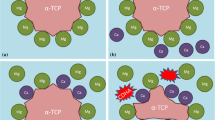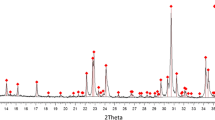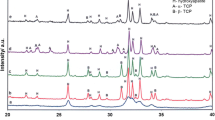Abstract
Addition of ductile polymers to calcium-deficient hydroxyapatite (CDHA)—forming bone cements based on α-tricalcium phosphate (α-TCP) is a promising approach to improve the mechanical performance of α-TCP cements and extend their application to load-bearing defects, which is else impeded by the brittleness of the hardened cement. One suitable polymer is poly-(2-hydroxyethylmethacrylate) (p-HEMA), which forms during cement setting by radical polymerisation of the monomer. In this study the hydration kinetics and the mechanical performance of α-TCP cements modified with addition of different HEMA concentrations (0–50 wt% in the cement liquid) was investigated by quantitative in situ XRD and four-point bending tests. Morphology of CDHA crystals was monitored by scanning electron microscopy. The hydration of α-TCP to CDHA was increasingly impeded and the visible crystal size of CDHA increasingly reduced with increasing HEMA concentration. Modification of the cements by adding 50 wt% HEMA to the cement liquid changed the brittle performance of the hardened cement to a pseudoplastic behaviour, reduced the flexural modulus and increased the work of fracture, while lower HEMA concentrations had no significant effect on these parameters. In such a composite, the extent of CDHA formation was considerably reduced (34.0 ± 1.8 wt% CDHA with 50 % HEMA compared to 54.1 ± 2.4 wt% CDHA in the reference formed after 48 h), while the general reaction kinetics were not changed. In conclusion, while the extent of CDHA formation was decreased, the mechanical properties were noticeably improved by addition of HEMA. Hence, α-TCP/HEMA composites might be suitable for application in some load-bearing defects and have adequate properties for mechanical treatment after implantation, like insertion of screws.











Similar content being viewed by others
References
Dorozhkin SV. Calcium orthophosphate cements for biomedical application. J Mater Sci. 2008;43(9):3028–57.
Gbureck U, Spatz K, Thull R, Barralet JE. Rheological enhancement of mechanically activated alpha-tricalcium phosphate cements. J Biomed Mater Res Part B. 2005;73B:1–6.
Canal C, Ginebra MP. Fibre-reinforced calcium phosphate cements: a review. J Mech Behav Biomed Mater. 2011;4:1658–71.
Moreau JL, Weir MD, Xu HHK. Self-setting collagen-calcium phosphate bone cement: mechanical and cellular properties. J Biomed Mater Res A. 2009;91A(2):605–13.
Schneiders W, Reinstorf A, Biewener A, Serra A, Grass R, Kinscher M, Heineck J, Rehberg S, Zwipp H, Rammelt S. In vivo effects of modification of hydroxyapatite/collagen composites with and without chondroitin sulphate on bone remodeling in the sheep tibia. J Orthop Res. 2009;27(1):15–21.
Wu TY, Zhou ZB, He ZW, Ren WP, Yu XW, Huang Y. Reinforcement of a new calcium phosphate cement with RGD-chitosan-fiber. J Biomed Mater Res Part A. 2014;102:68–75.
Xu HHK, Simon CG. Fast setting calcium phosphate-chitosan scaffold: mechanical properties and biocompatibility. Biomaterials. 2005;26:1337–48.
dos Santos LA, Carrodeguas RG, Boschi AO, de Arruda ACF. Fiber-enriched double-setting calcium phosphate bone cement. J Biomed Mater Res Part A. 2003;65A(2):244–50.
dos Santos LA, Carrodeguas RG, Boschi AO, de Arruda ACF. Dual-setting calcium phosphate cement modified with ammonium polyacrylate. Artif Organs. 2003;27(5):412–8.
Wang J, Liu CS, Liu YF, Zhang S. Double-network interpenetrating bone cement via in situ hybridization protocol. Adv Funct Mater. 2010;20(22):3997–4011.
Christel T, Kuhlmann M, Vorndran E, Groll J, Gbureck U. Dual setting alpha-tricalcium phosphate cements. J Mater Sci Mater Med. 2013;24(3):573–81.
Ginebra MP, Fernandez E, Driessens FCM, Planell JA. Modeling of the hydrolysis of α-tricalcium phosphate. J Am Ceram Soc. 1999;82(10):2808–12.
Gbureck U, Grolms O, Barralet JE, Grover LM, Thull R. Mechanical activation and cement formation of beta-tricalcium phosphate. Biomaterials. 2003;24:4123–31.
Jansen D, Stabler Ch, Goetz-Neunhoeffer F, Dittrich S, Neubauer J. Does Ordinary Portland Cement contain amorphous phase? A quantitative study using an external standard method. Powder Diffr. 2011;26:31–8.
Mathew M, Schroeder LW, Dickens B, Brown WE. The crystal structure of α-Ca3(PO4)2. Acta Crystallogr B. 1977;33:1325–33.
Sudarsanan K, Young RA. Significant precision in crystal structural details: Holly Springs hydroxyapatite. Acta Crystallogr Sect B. 1969;25:1534–43.
Ectors D, Goetz-Neunhoeffer F, Neubauer J. A generalized geometric approach to anisotropic peak broadening due to domain morphology. J Appl Crystallogr. 2015;48:189–94.
International Union for Crystallography, Prince E. International Tables for Crystallography, Volume C. Mathematical Physical and Chemical Tables. 3rd ed. New York: Wiley; 2004.
Wojdyr M. Fityk: a general-purpose peak fitting program. J Appl Crystallogr. 2010;43:1126–8.
Hurle K, Neubauer J, Bohner M, Doebelin N, Goetz-Neunhoeffer F. Effect of amorphous phases during the hydraulic conversion of α-TCP into calcium deficient hydroxyapatite. Acta Biomater. 2014;10(9):3931–41.
Psycharis V, Kalamakis N, Boukos N, Trapalis C, Bourlinos A, Karakasides M. Chemical and X-ray diffraction peak broadening analysis, electron microscopy and ir studies of biological apatites. Mater Sci Forum. 2001;378–381:759–64.
Hayakawa T, Mochizuki C, Hara H, Fukushima T, Yang F, Shen H, Wang S, Sato M. Influence of apatite crystallinity in porous PLGA/apatite composite scaffold on cortical bone response. J Hard Tissue Biol. 2009;18(1):7–12.
Momma K, Izumi F. VESTA 3 for three-dimensional visualization of crystal, volumetric and mophology data. J Appl Crystallogr. 2011;44:1272–6.
Author information
Authors and Affiliations
Corresponding author
Rights and permissions
About this article
Cite this article
Hurle, K., Christel, T., Gbureck, U. et al. Reaction kinetics of dual setting α-tricalcium phosphate cements. J Mater Sci: Mater Med 27, 1 (2016). https://doi.org/10.1007/s10856-015-5616-y
Received:
Accepted:
Published:
DOI: https://doi.org/10.1007/s10856-015-5616-y




